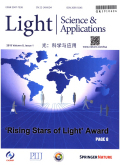- 钛学术文献服务平台 \
- 学术期刊 \
- 工业技术期刊 \
- 电工技术期刊 \
- 光:科学与应用(英文版)期刊 \
Time-expanded phase-sensitive optical time-domain reflectometry
Time-expanded phase-sensitive optical time-domain reflectometry
基本信息来源于合作网站,原文需代理用户跳转至来源网站获取
摘要:
Phase-sensitive optical time-domain reflectometry (ΦOTDR) is a well-established technique that provides spatio-temporal measurements of an environmental variable in real time. This unique capability is being leveraged in an ever-increasing number of applications, from energy transportation or civil security to seismology. To date, a wide number of different approaches have been implemented, providing a plethora of options in terms of performance (resolution, acquisition bandwidth, sensitivity or range). However, to achieve high spatial resolutions, detection bandwidths in the GHz range are typically required, substantially increasing the system cost and complexity. Here, we present a novelΦOTDR approach that allows a customized time expansion of the received optical traces. Hence, the presented technique reaches cm-scale spatial resolutions over 1 km while requiring a remarkably low detection bandwidth in the MHz regime. This approach relies on the use of dual-comb spectrometry to interrogate the fibre and sample the backscattered light. Random phase-spectral coding is applied to the employed combs to maximize the signal-to-noise ratio of the sensing scheme. A comparison of the proposed method with alternative approaches aimed at similar operation features is provided, along with a thorough analysis of the new trade-offs. Our results demonstrate a radically novel high-resolutionΦOTDR scheme, which could promote new applications in metrology, borehole monitoring or aerospace.

推荐文章
“磨”出精彩“,优”化教学--译林英语What time is it?的Story time板块磨课
导入
新知呈现
阅读故事
巩固拓展
反思
核心素养视野下的小学英语Story time教学探究
Storytime教学
核心素养
整合高效
内容分析
关键词云
关键词热度
相关文献总数
(/次)
(/年)
文献信息
| 篇名 | Time-expanded phase-sensitive optical time-domain reflectometry | ||
| 来源期刊 | 光:科学与应用(英文版) | 学科 | |
| 关键词 | |||
| 年,卷(期) | 2021,(3) | 所属期刊栏目 | Articles |
| 研究方向 | 页码范围 | 443-454 | |
| 页数 | 12页 | 分类号 | |
| 字数 | 语种 | 英文 | |
| DOI | |||
五维指标
引文网络
引文网络
二级参考文献 (0)
共引文献 (0)
参考文献 (36)
节点文献
引证文献 (0)
同被引文献 (0)
二级引证文献 (0)
1993(1)
- 参考文献(1)
- 二级参考文献(0)
2002(1)
- 参考文献(1)
- 二级参考文献(0)
2003(1)
- 参考文献(1)
- 二级参考文献(0)
2005(1)
- 参考文献(1)
- 二级参考文献(0)
2006(1)
- 参考文献(1)
- 二级参考文献(0)
2007(1)
- 参考文献(1)
- 二级参考文献(0)
2008(1)
- 参考文献(1)
- 二级参考文献(0)
2009(2)
- 参考文献(2)
- 二级参考文献(0)
2010(2)
- 参考文献(2)
- 二级参考文献(0)
2011(1)
- 参考文献(1)
- 二级参考文献(0)
2012(2)
- 参考文献(2)
- 二级参考文献(0)
2014(5)
- 参考文献(5)
- 二级参考文献(0)
2015(4)
- 参考文献(4)
- 二级参考文献(0)
2016(5)
- 参考文献(5)
- 二级参考文献(0)
2017(2)
- 参考文献(2)
- 二级参考文献(0)
2018(2)
- 参考文献(2)
- 二级参考文献(0)
2019(3)
- 参考文献(3)
- 二级参考文献(0)
2020(1)
- 参考文献(1)
- 二级参考文献(0)
2021(0)
- 参考文献(0)
- 二级参考文献(0)
- 引证文献(0)
- 二级引证文献(0)
引文网络交叉学科
相关学者/机构
期刊影响力
光:科学与应用(英文版)
主办单位:
中国科学院长春光学精密机械与物理研究所
出版周期:
双月刊
ISSN:
2095-5545
CN:
22-1404/O4
开本:
出版地:
吉林省长春市东南湖大路3888号
邮发代号:
创刊时间:
语种:
eng
出版文献量(篇)
762
总下载数(次)
0
总被引数(次)
112
期刊文献
相关文献
推荐文献
- 期刊分类
- 期刊(年)
- 期刊(期)
- 期刊推荐
一般工业技术
交通运输
军事科技
冶金工业
动力工程
化学工业
原子能技术
大学学报
建筑科学
无线电电子学与电信技术
机械与仪表工业
水利工程
环境科学与安全科学
电工技术
石油与天然气工业
矿业工程
自动化技术与计算机技术
航空航天
轻工业与手工业
金属学与金属工艺
光:科学与应用(英文版)2022
光:科学与应用(英文版)2021
光:科学与应用(英文版)2020
光:科学与应用(英文版)2019
光:科学与应用(英文版)2018
光:科学与应用(英文版)2017
光:科学与应用(英文版)2016
光:科学与应用(英文版)2021年第9期
光:科学与应用(英文版)2021年第8期
光:科学与应用(英文版)2021年第7期
光:科学与应用(英文版)2021年第6期
光:科学与应用(英文版)2021年第5期
光:科学与应用(英文版)2021年第4期
光:科学与应用(英文版)2021年第3期
光:科学与应用(英文版)2021年第2期
光:科学与应用(英文版)2021年第12期
光:科学与应用(英文版)2021年第11期
光:科学与应用(英文版)2021年第10期
光:科学与应用(英文版)2021年第1期

 免费查重
免费查重










